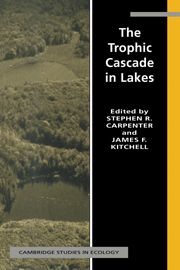Book contents
- Frontmatter
- Contents
- Contributors
- Preface
- 1 Cascading trophic interactions
- 2 Experimental lakes, manipulations and measurements
- 3 Statistical analysis of the ecosystem experiments
- 4 The fish populations
- 5 Fish behavioral and community responses to manipulation
- 6 Roles of fish predation: piscivory and planktivory
- 7 Dynamics of the phantom midge: implications for zooplankton
- 8 Zooplankton community dynamics
- 9 Effects of predators and food supply on diel vertical migration of Daphnia
- 10 Zooplankton biomass and body size
- 11 Phytoplankton community dynamics
- 12 Metalimnetic phytoplankton dynamics
- 13 Primary production and its interactions with nutrients and light transmission
- 14 Heterotrophic microbial processes
- 15 Annual fossil records of food-web manipulation
- 16 Simulation models of the trophic cascade: predictions and evaluations
- 17 Synthesis and new directions
- References
- Index
16 - Simulation models of the trophic cascade: predictions and evaluations
Published online by Cambridge University Press: 06 August 2010
- Frontmatter
- Contents
- Contributors
- Preface
- 1 Cascading trophic interactions
- 2 Experimental lakes, manipulations and measurements
- 3 Statistical analysis of the ecosystem experiments
- 4 The fish populations
- 5 Fish behavioral and community responses to manipulation
- 6 Roles of fish predation: piscivory and planktivory
- 7 Dynamics of the phantom midge: implications for zooplankton
- 8 Zooplankton community dynamics
- 9 Effects of predators and food supply on diel vertical migration of Daphnia
- 10 Zooplankton biomass and body size
- 11 Phytoplankton community dynamics
- 12 Metalimnetic phytoplankton dynamics
- 13 Primary production and its interactions with nutrients and light transmission
- 14 Heterotrophic microbial processes
- 15 Annual fossil records of food-web manipulation
- 16 Simulation models of the trophic cascade: predictions and evaluations
- 17 Synthesis and new directions
- References
- Index
Summary
Introduction
Previous chapters have detailed the responses of Peter and Tuesday Lakes to fish manipulations. Some of the changes were anticipated, while others were surprises. Our research was guided by models of the trophic cascade in lakes. To what extent did these models forecast the experimental results? The purpose of this chapter is to assess how our predictions fared, and how our view of the trophic cascade has been modified by the experimental outcome. First, we must explain why we developed simulation models of the trophic cascade, how the models were structured, and the predictions that derived from the models.
The trophic cascade is, in essence, a simple idea. In the complexity of real lakes, however, it involves the collective outcome of life history, predator–prey, and physical–chemical processes that cannot be adequately represented by simple verbal, graphical or mathematical models. Computer simulations are one way of integrating these complex interactions. They elaborate the conceptual framework and develop specific, testable predictions. We began simulation studies of the trophic cascade in 1981, three years before initiating the ecosystem experiments. Many of the predictions of those models can now be evaluated.
This chapter has four parts. First, we review three simulation models that produced the hypotheses we tested in the field. Second, we address predictions specific to the outcome of our ecosystem experiments. Third, we turn to more general expectations that should apply to trophic cascades in many lakes.
Information
- Type
- Chapter
- Information
- The Trophic Cascade in Lakes , pp. 310 - 331Publisher: Cambridge University PressPrint publication year: 1993
Accessibility standard: Unknown
Why this information is here
This section outlines the accessibility features of this content - including support for screen readers, full keyboard navigation and high-contrast display options. This may not be relevant for you.Accessibility Information
- 2
- Cited by
